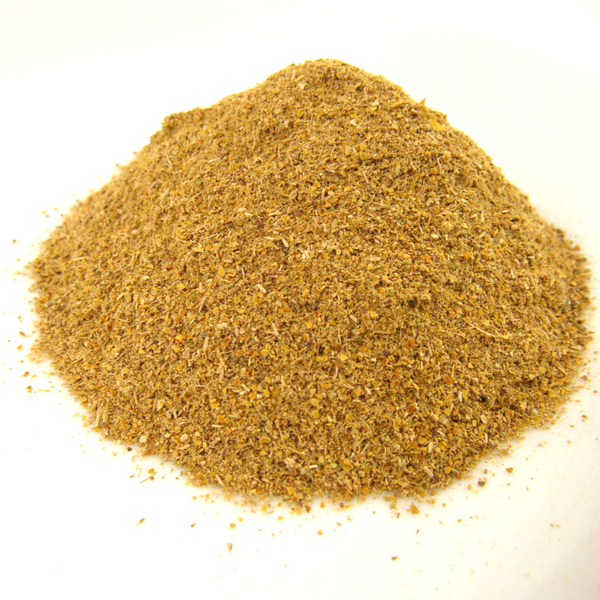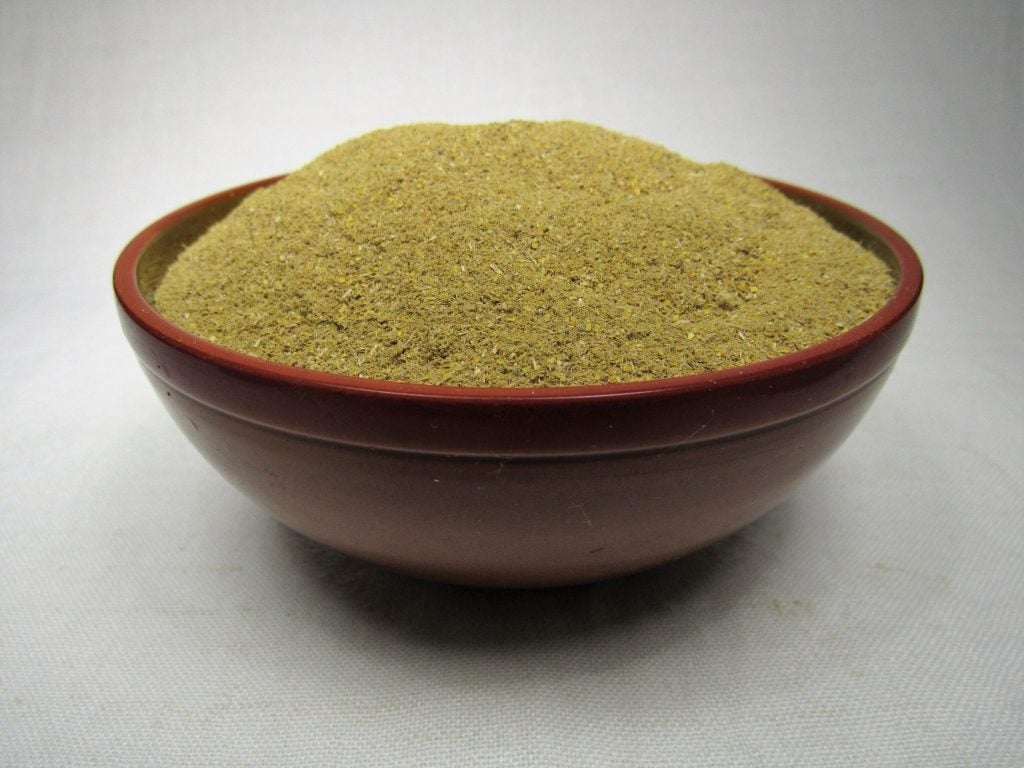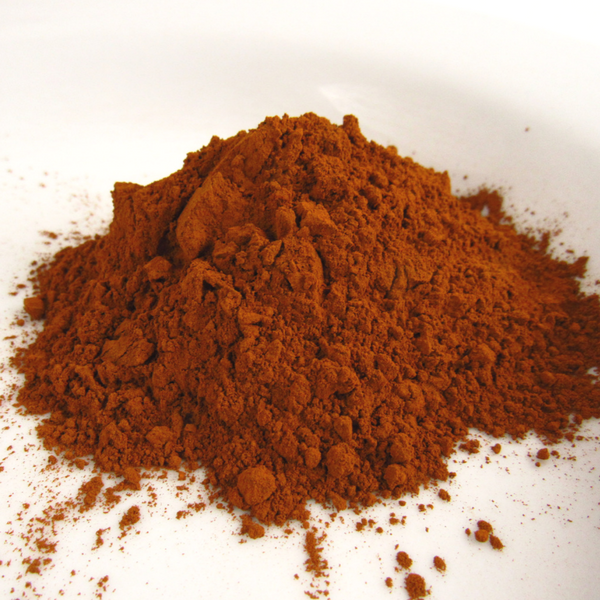
Our How To guides are intended to make the mordant process easy, from scouring your fibers to dyeing with an assortment of dyes. You can find other How To guides here.
What is Mordanting?
Mordanting is the most important process of preparing fibers to accept color. Using a mordant helps to ensure the most durable and long-lasting colors. With the exception of indigo (as a vat dye, it does not require a mordant), this is not an optional step.
(Check out our Q & A: Round Up of Mordanting + Scouring 101 here.)
Most mordants are calculated based off of a percentage of the weight of fiber or WOF. Weight of fiber (WOF) refers to the dry weight of the yarn or fabric to be mordanted. It is used primarily when weighing mordants and dyes and allows you to quickly and easily calculate how much to measure. Therefore, a kitchen scale is handy to determine the weight of yarns or fabrics.
Mordanting with Symplocos
We are happy to offer symplocos (Symplocos cochinchinensis) dried leaf powder as a plant mordant from Indonesia. The fallen leaves are rich in alum from endangered forests. As a result, we support a sustainable crop rather than felling trees for their lumber. As natural dyers, we have access to various plant-derived tannins for mordanting options. However, there are few alum-accumulators available to us in commercial form. Symplocos offers an exciting alternative.
The Plant Mordant Project offers natural dyers a unique opportunity to make reliable colors 100% from plants. Powdered leaves from symplocos trees can replace aluminum sulfate in conventional natural dye recipes. In addition, they can produce exciting new colors. Natural dyers already choose plant dyes over synthetic dyes because they are aligned with their values. So the Plant Mordant Project offers an opportunity to extend the expression of these values by also using a plant-sourced mordant.
At its source, the Plant Mordant Project builds partnerships for sustainability with rainforest communities and indigenous textile artists in Indonesia. The Bebali Foundation alleviates rural poverty and empowers women through its sourcing and sales of Indonesia’s traditional plant-sourced dye mordant. In addition, it saves rainforests, and supports the traditional textile arts. The Bebali Foundation brings to this project a decade of experience in the fields of conservation, indigenous culture, and rural livelihoods. In addition, its partnerships with the Royal Botanical Gardens at Kew and the Indonesian Forestry Department, as well as its funding from the Ford Foundation, bring world class scientific rigor and accountability.
The information below is all taken from the Plant Mordant Project site.

Mordanting wool fibers
Cleaning the wool
- Determine the dry weight of the fiber (WOF).
- The yarn or fabric must be clean and degreased. Soak the wool in a weak, warm solution of sodium carbonate (also known as washing soda or soda ash), or in a lye solution from plant ashes, at ph 9 to 9.5, for 30 minutes
- Rinse well in warm water.
Mordanting with Symplocos
- Weigh out an amount of symplocos equal to half the weight of the fiber or 50% WOF.
- Boil the symplocos in soft water for 30 minutes, until it sinks to the bottom of the pot.
- You may filter this liquid, if you are using yarn. If you are mordanting cloth, it is not necessary to filter, since it is easy to remove the symplocos particles from the cloth later, by rinsing.
- Cool the liquid to 40ºC (104ºF).
- Put the wet wool yarn or fabric into the liquid.
- Heat very gently for an hour, to the simmering point, 95ºC (200ºF).
- Rinse the wool in warm water. Be careful not to shock the wool with cold water, or it will felt. When rinsed, your fiber will be a pale shade of yellow. This yellow color tells you that the fiber has been successfully mordanted by the symplocos. The yellow will disappear after dyeing and will not influence the final color.
- At this point, you can dry and store the fiber for dyeing later, or you can proceed to dyeing the fiber.
Dyeing process
Now your fiber is ready to dye! All mordant dyes are usable with this process. With dried dye materials, use 100% WOF. For most concentrated dye extracts, use 10% WOF. The exception is logwood extract, of which much less can be used: between 5% for dark shades and 1% for light shades.
- Soak the dyestuff for 30 minutes in warm water at 30ºC (86ºF).
- Add the fiber to the dye bath.
- Raise the temperature slowly, over the course of 1 hour, to 90ºC (194ºF).
- Maintain the temperature at 90ºC (194ºF) for another 1 hour in order to develop the color completely. Do not boil.
- Let the fiber cool in the dye bath.
- Rinse in warm water.
Mordanting silk fibers

Cleaning the silk
- Determine the dry weight of the fiber (WOF).
- Soak the silk in a weak, warm soap solution (such as Marseille soap, olive oil soap, etc.) at 60ºC/140ºF for 1 hour.
- Rinse well in warm water.
Mordanting with Symplocos
- Weigh out an amount of symplocos equal to half the weight of the fiber or 50% WOF.
- Boil the symplocos in soft water for 30 minutes, until it sinks to the bottom of the pot.
- You may filter this liquid, if you are using yarn. If you are mordanting cloth, it is not necessary to filter, since it is easy to remove the symplocos particles from the cloth later, by rinsing.
- Soak the silk in the symplocos liquid for at least 30 minutes at 80ºC (176ºF).
- Rinse the silk in warm water. When rinsed, your fiber will be a pale shade of yellow. This yellow color tells you that the fiber has been successfully mordanted by the symplocos. The yellow will disappear after dyeing and will not influence the final color.
- At this point, you can dry and store the fiber for dyeing later, or you can proceed to dyeing the fiber.
Dyeing process
Now your fiber is ready to dye! All mordant dyes are usable with this process. With dried dye materials, use 100% WOF. For most concentrated dye extracts, use 10% WOF. The exception is logwood extract, of which much less can be used: between 5% for dark shades and 1% for light shades.
- Soak the dyestuff for 30 minutes in warm water at 30ºC (86ºF).
- Add the fiber to the dye bath.
- Raise the temperature slowly, over the course of 1 hour, to 85ºC (185ºF).
- Maintain the temperature at 85ºC for 30 – 60 minutes in order to develop the color completely. Do not boil.
- Let the fiber cool in the dye bath.
- Rinse in warm water.
Mordanting cellulose (plant-based) fibers

Dyeing cellulose is more complicated than dyeing protein fibers. There are a myriad recipes from all over the world. What follows is a distillation of these variations. It is a basic recipe for strong, saturated, lightfast colors. If you take the time to dry the fiber thoroughly between each step, you will improve your results.
Oiling the cellulose fiber
- Determine the dry weight of the fiber (WOF).
- Soak the yarn or fabric in a solution of 10% WOF turkey red oil in water at 60ºC (140ºF) for at least 1 hour.
- Dry thoroughly. This is important because oxidizing the oil turns it rancid, separating the fatty acids from the oil, and fixing it onto the fiber.
- Store the fiber for later use, or proceed to the next step.
Tannin process
- Soak the fiber in a solution of gall nut extract 10% WOF at 60ºC (140ºF) for 60 minutes. Gall nut extract is a gallic tannin well suited to protecting the lightfastness of the dye.
- Allow to steep overnight.
- Rinse and then dry thoroughly. Again, you can store the fiber now for later use, or proceed to the next step.
Mordanting with Symplocos
- Weigh out an amount of symplocos equal to half the weight of the fiber or 50% WOF.
- Boil the symplocos in soft water for 60 minutes, or until it sinks to the bottom of the pot.
- You may filter this liquid, if you are using yarn. If you are mordanting cloth, it is not necessary to filter, since it is easy to remove the symplocos particles from the cloth later, by rinsing.
- Soak the fiber in the symplocos liquid for at least 30 minutes at 60ºC (140ºF).
- Rinse the fiber in warm water. When rinsed, your fiber will be a pale shade of yellow indicating successful mordanting by the symplocos. The yellow will disappear after dyeing and will not influence the final color.
- Dry thoroughly. Again, you can store the fiber now for later use, or proceed to the next step.
Dyeing process
Now your fiber is ready to dye! All mordant dyes can be used with this process.
For dried or fresh dye materials, use 100% WOF
- Boil the fresh or dried dye material, 100% WOF, in water, for at least 30 minutes.
- Filter the dye bath, cool to 60ºC (140ºF), and add the fiber.
- Heat gently, over the course of 1 hour to 90ºC (194ºF), and keep at this temperature for 60 minutes.
- Rinse and dry.
For concentrated dye extracts, use 10% WOF
- Dissolve the extract, 10% WOF, in warm water, add the fiber.
- Heat gently, over the course of 1 hour to 90ºC (194ºF), and keep at this temperature for 60 minutes.
- Rinse and dry.

For Madder
Madder must be treated more gently than other mordant dyes. If it is heated too quickly it will turn brown.
- Dilute finely powdered madder root at 100% WOF, or madder extract at 10% WOF, in warm water 40ºC (104ºF).
- Add the fiber. Warm very slowly, over the course of 1 hour, to 60ºC (140ºF).
- Over the next hour, heat to 80ºC (176ºF).
- Cool the fiber in the dye bath.
- Then rinse and dry.
For Logwood and Cochineal extracts
- With logwood extract, much less can be used: between 5% for dark shades and 1% for light shades.
- With cochineal extract, much less can be used: between 5% for dark shades and 2.5% for light shades.
Experimental Variables
These are basic and reliable recipes for using symplocos for mordanting. With experience, you will find that there are 4 main variables that affect this process:
- The amount of symplocos used as a percentage of the dry weight of the fiber (% WOF).
- The amount of time the fiber is heated in a solution of the symplocos.
- The temperature to which the symplocos and fiber are heated together.
- The amount of dyestuff used.
You may find, as you become experienced with using symplocos, that you can use less with particular dyestuffs, that you can use a smaller amount of a particular dyestuff and still get good results, or that you can use a lower temperature if you keep the fiber in the bath for a longer amount of time, for example overnight.
In our experiments to develop these recipes we tried using the symplocos at varying percentages of WOF. We tried: 5%, 10%, 20%, 30%, 50%, 90% and 100%. We started to get good colors with 20% on silk and wool. As we increased the percentage of symplocos, we continued to get better (darker, richer) colors. This was true with some dyestuffs more than others. For example, with cutch and pomegranate, which are both tannins, increasing the percentage of symplocos beyond 20% made little difference. With cochineal, osage, weld and especially madder, it made a lot of difference. That is why we are recommending that you begin by using 50% WOF to ensure a good result. It is also true that if you use a large percentage of symplocos, you can use less dyestuff. This is especially true with logwood.
Printing with Symplocos paste
Symplocos powder can be made into a paste to be used for silkscreening, block printing, or painting. First, a concentrated solution is made with the powder and water, then it must be thickened. We recommend using guar gum as a thickener, though gum tragacanth would also work. The guar gum powder can be added directly to the symplocos solution and then stirred. Alternatively, the guar gum can be made into a paste first and then this pudding-like substance can be added to the symplocos. This dissolves much easier than the plain guar gum powder. Guar Gum is available at the grocery store in the baking section, or from dye suppliers. Prepare the thickener paste a few hours, or even the day, before you need to use it. This recipe will make 1 liter (1 quart) of thickener. (Reduce appropriately if you do not need the full amount).
- Measure 1000 ml (1 quart) of water at room temperature, 25ºC (75ºF).
- In a separate dry container measure 100 grams (1 cup) of guar gum.
- Using an electric hand mixer (you will not be able to mix this by hand), start blending just the water. Then gradually sprinkle in the guar gum. Continue blending until well mixed.
- Allow to stand for several hours or overnight for a smooth paste. NOTE: This thickener will keep for only three days. It is also possible to put the guar gum into several small containers to freeze for later use.
1. On Cotton
Symplocos paste recipe for printing on cotton
- Add 50 grams of symplocos powder to 300 ml of water.
- Boil for 30 minutes. Add more water as necessary.
- Filter the liquid, squeezing all liquid from the symplocos pulp.
- Add more water to the liquid until its volume is equal to 300 ml again.
- Add 3 grams of dry guar gum or about 1 tablespoon of guar gum paste and stir continuously until all the lumps are gone. Add more if it is not thick enough.
Preparing the cloth
- Using cloth that has been properly cleaned, determine the dry weight of the cloth (WOF).
- Soak the cloth in turkey red castor oil 10% WOF and enough water to cover the cloth at 60ºC (140ºF) for 1 hour.
- Dry the cloth.
- Soak the cloth in a preparation of 10% WOF tannin and enough water to cover the cloth at 60ºC (140ºF) for at least 1 hour or overnight.
- Dry the cloth again.
- Print with the prepared symplocos paste and dry thoroughly.
- Rinse in a solution of hot tap water and a handful of wheat bran. The phosphates in the wheat bran will
- set the mordant on the cloth.
- Now the cloth is ready for dyeing, using the usual methods.
2. On Silk
Symplocos paste recipe for printing on silk
- Add 50 grams of symplocos powder to 300 ml of water.
- Boil for 30 minutes. Add more water as necessary.
- Filter the liquid, squeezing all liquid from the symplocos pulp.
- Add more water to the liquid until its volume is equal to 300 ml again.
- Add 3 grams of dry guar gum or about 1 tablespoon of guar gum paste and stir continuously until all the lumps are gone. Add more if it is not thick enough.
Preparing the cloth
- Start with clean/scoured silk fabric that has been washed in a warm soap solution.
- Print with the prepared symplocos print paste and dry thoroughly.
- Rinse in a solution of hot tap water and a handful of wheat bran. The phosphates in the wheat bran will set the mordant on the cloth.
- Now the cloth is ready for dyeing, using the usual methods.
You might also like to read:
Q & A: Round Up of Mordanting + Scouring 101
Video of Live Q&A For (New Cold Water Mordant) Aluminum Triformate
Our weekly Mordant Monday series!
Shop:
Symplocos
Yarn Dye Rings
Catharine Ellis and Joy Boutrup’s book, The Art and Science of Natural Dyes
